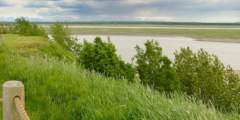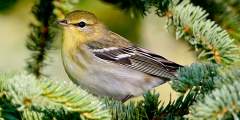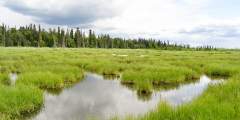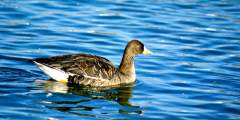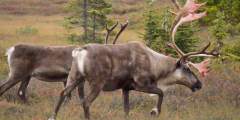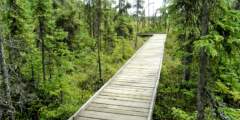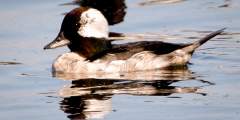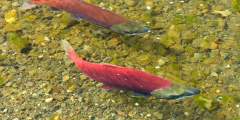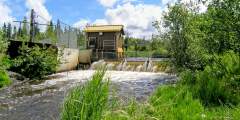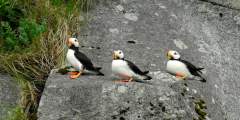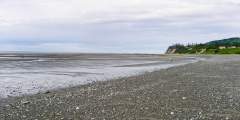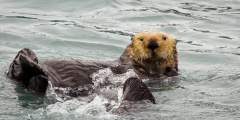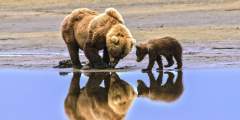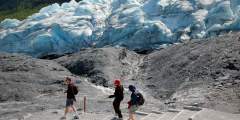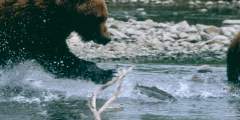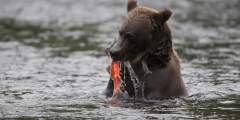Kenai Peninsula Wildlife Audio Guide
Known as Alaska’s Playground, the Kenai Peninsula is one of the state’s most beautiful and accessible areas. A wealth of roads and trails offers the potential for amazing wildlife viewing: birds, seabirds, whales, bears, moose, and caribou are all here. Of course, these critters don’t just magically appear when you walk by. So we consulted longtime wildlife biologists to put together an audio guide to three dozen hot spots that offer the best chance of spotting wildlife. We’ll take you to specific points—everywhere from the highway to backcountry trails—and give you detailed advice on where to look and what to listen for. This tour vastly increases your chances of seeing the Kenai Peninsula’s unique wildlife. Don’t go to the Kenai without it!
Show Map
Points of Interest
Kenai Peninsula Wildlife Audio Guide
Sounds Wild: Mother BatsThis recreational site has a series of loop trails that pass two small lakes. Park in the parking lot and take the path to your left as you face the buildings; this will lead you to the trailhead. The trail is great for viewing woodland birds and loons on the lake. As evening approaches, look for bats flying over the lake feeding on insects. Bats are hard to see because they are very secretive and do not become active… ...more
Stop off here during the summer for an eagle’s eye view of an annual Alaskan fishing frenzy. We really love our salmon, and it shows! Or, just count the bald eagles circling high overhead.
Sounds Wild: Eagles Lifetime MatesWant to see a soaring eagle up close? Stop at this site near the senior center and walk out toward the bluff – not too close as the bluff is eroding. Eagles play in the wind along the bluff. If not flying they can be seen on the mud flats at low tide– looking for food that has washed downstream.More Information ...more
Choose this site and you have a good opportunity to spot some “charismatic megafauna.” Moose and caribou can often be found grazing along this oilfield service road, which runs adjacent to some prime wildlife habitat.
Sounds Wild: PhalaropesHundreds of red-necked phalaropes can be seen from the end of the Homer Spit during their spring and fall migrations. Look for these small birds spinning in circles on the water. They do this to concentrate food. These whirling living tops are a joy to watch. They tend to be in small flocks, which can make spotting them easier.More Information ...more
Definitely keep your eyes open here, there’s volcanoes, beluga whales, harbor seals, and tons of birdlife to be seen — depending on the season and weather, of course. Extra credit if you spot an owl!
Sounds Wild: Pond-Bottom MooseThe wetlands where the Kenai Spur Highway crosses Beaver Creek are great for viewing moose in the early morning or late evening. Like most streams on the Kenai Peninsula, the streamside vegetation consists of willows- a favorite food of moose. Look to your right as you head toward Kenai and check out all the wetland areas for the next couple of miles.More Information ...more
Not Steinbeck’s classic novel, but a fantastic adventure, communing with a 30,000-member herring gull colony. It’s a one-of-a-kind experience you won’t want to miss.
Let’s go caribou-spotting on the wide open spaces at the mouth of the world-famous river system. This spot is one of your best bets for viewing these beautiful, stately beasts.
Sounds Wild: Caribou Caribou can be seen anywhere on the Kenai River estuarine area but are more frequently seen on the east side of the Bridge Access Road. They have their calves here in the spring and feed the rest of the summer and fall. They are commonly seen but there are no guarantees with caribou. More Information
Walk out to the boardwalks along the Kenai River, learn about riverine habitat and the salmon lifecycle, and witness the timeless dance of hunter and hunted, of fish and fisher. One year-round resident here will impress you with their winter survival skills.
The Keen-Eye Nature Trail is .75 miles long through a wooded area with a side trail leading down to Headquarters Lake. The Centennial Trail provide an additional 1.9 mile loop through a wooded area with further opportunity to view wildlife in the area.
Stretch your legs here and check out one of the favorite rest stops for thousands of Kenai River salmon on their journey home. We’ll also seek out giant trumpeter swans, red-necked grebes, and of course, fishers of another species — humans. Here at the confluence, the two rivers reveal their source waters in a very clear visual demonstration.
Sounds Wild: Alaska’s DragonsWatson Lake is a shallow lake that is full of vegetation – just the right spot for dragonflies and other critters. Standing at the boat launch and camping area, look out across the lake for these large flying insects. Red-necked grebes, rusty blackbirds and loons are also found on the lake. Most lakes on the Kenai Peninsula can be a good spot for dragonflies.More Information ...more
You’ll either enjoy a peaceful walk through a secluded and beautiful estuary ripe with birdlife — or have a ringside seat at the annual salmon dipnetting extravaganza, featuring hordes of crazed locals armed with 10-foot poles. The beach road emerges from the forest at a river-mouth lined by dunes, tidally influenced beach, an estuary and broad salt marsh.
Join us as we drift downstream through one of the world’s most beautiful freshwater salmon fisheries, passing gravel bars left by a glacial flood, migrating salmon, brown bears, and human fishers as you float on by.
Sounds Wild: SparrowsSavannah sparrows love to sing and hide in the grass. However, sometimes they will perch on a fence, small trees or brush piles in this estuarine area. Walk along the beach toward the Kasilof River and look at the large flats to your right. In addition to sparrows you will see arctic terns, numerous herring, mew gulls and migrating shorebirds in the spring and fall.More Information ...more
King salmon are famous for being the largest salmon species. Here’s your chance to see some kings (otherwise known as chinooks) up close as they “pose” for your photos, and learn about their fascinating lifecycle.
Sounds Wild: Porky BabiesPorcupines are not often seen along the main paved roads of the Kenai Peninsula. You have to get off on the gravel side roads that pass through their habitat. Tustumena Lake road travels through the Kenai Wildlife Refuge and ends at the Kasilof River campground. This road is great for viewing various birds including spruce grouse, thrushes and chickadees. Moose are found along this road and if you are really lucky, a… ...more
Witness giant tractors towing the Kenai Peninsula’s fleet out to water’s edge and launching them into the tide on their quest for fish. You can camp here, scout for wildlife, fish for steelhead, and enjoy some of the best puffin viewing on the Kenai.
Everyone wants to explore a tidepool, don’t they? This is a must for the kids — even that little kid in those slightly more mature visitors. Here’s the perfect spot. Bring a towel and let’s have an intertidal adventure.
To all the other great reasons to visit Homer, add plentiful shorebirds, seabirds, marine mammals, and a ring of stunning mountain peaks surrounding Kachemak Bay. The Islands and Ocean Visitors Center puts the icing on this cake.
Sounds Wild: Marked MammalsSea lions come and go in the Homer area but one spot to check out is the fish processing plant at the south end of the small boat harbor. When commercial fishermen unload their catch, some fish and crabs are thrown overboard. Sea lions love this easy meal. Watch the harbor entrance as sea lions sometimes like to swim just outside this congested dock area. However, the best way to see them is to take a cruise in the… ...more
Sounds Wild: Ravens HotWherever there is food, you will find ravens and northwest crows. In fact crows love people and their food. At the Homer Small Boat Harbor you can find these birds feeding along the shore, in the campgrounds and perched on the surrounding telephone poles and buildings.More Information
Sounds Wild: AltricialFor many years an elderly lady fed eagles at this spot during the winter months: “The Eagle Lady of Homer Spit.” Her house was right on the beach and she received fish waste from a local fish processor, which she would then give to the hundreds of eagles that would show up for their daily feeding. After she passed away this practice of feeding the eagles was stopped.More Information ...more
Sounds Wild: Underground SeabirdsA great spot on the Kenai Peninsula to see a large group of seabirds nesting is Gull Island out of Homer. This short three-mile boat ride across Kachemak Bay is great for families. You’ll also find red-faced cormorants, common murres, puffins, eagles, murrelets, sea otters, harbor seals, sea lions and even whales.More Information ...more
Sounds Wild: Thar She BlowsWhales, dolphins, sea otters, harbor seals and sea lions are all visible in Kenai Fjords National Park. While you might see some of these animals from shore, the best option is a day cruise out of Seward. A number of companies offer these services and you will not be disappointed. Glaciers and birds top the list.More Information ...more
Just south of Seward you could spot humpback whales, sea lions, bird life and old growth forest habitat. There’s a great sand beach at the end that will reward your exploration, so let’s go!
At the Seward Small Boat Harbor look out at the rock jetties and buoys. Eagles like to sit on these spots and monitor their domain. Food is also plentiful from fisherman cleaning fish, seabirds that stay in the area and fish that return to the streams nearby.
By midday, fishing boats have returned with their catch. Walk over to the fish cleaning tables to see halibut, salmon, and other quarry from the deep.
You can hike right up to Seward’s Exit Glacier and feel the dense blue ice while listening to it crackle. Walk the lower trail to get a good photo in front of the glacier face. Or, choose the more challenging 7‑mile round-trip Harding Icefield Trail. There is a short ranger-led walk daily at 11am and 3pm, from Memorial Day through Labor Day.
The salmon lifecycle and a working salmon-counting operation is on the menu here, as well as a fresh salmon for your dinner, if you time your visit just right. Hear how!
Great sockeye salmon observation site, especially in late July and early August. At other times of year it offers a moderate walk up to Ptarmigan Lake that’s great for families and features lots of bird life.
Sounds Wild: Birds SmellTern Lake has lots to offer but few people use the old Sterling highway to access the boreal forest near this lake. Drive into the recreational area and as you turn left toward the restrooms you will see an old road to your right. You can walk for miles down this road and enjoy the smell of the woods and the sound of the birds.More Information ...more
Sounds Wild: LoonsAs you approach Summit Lakes, look for common loons. Most of the time they are found at the southern end of the lakes near the shore but can be anywhere, so stop at the lodge and road pullouts to look at the lake surface. Moose can sometimes be seen in the marsh areas at the end of the lakes.More Information
Grab your optics and let’s take in the 360-degree view here at the start of the Kenai River, Alaska’s world-renowned salmon fishing hot spot. See wildlife up on the hillsides, songbirds, waterfowl, and the brilliant ice-blue Kenai Lake and River. Breathtaking.
Sounds Wild: Trees Need SalmonAs you drive toward Soldotna you will see the Kenai River on your left. This river has thousands of salmon spawning in it each year. Mostly sockeye or red salmon but also coho or silver salmon, chinook or king salmon and pink or humpy salmon. After these salmon die, they float downstream and are deposited along the riverbank where they decompose and provide food to the riverside plants.More Information ...more
This wildlife sweet spot is worth a visit. The Russian Lakes Trail begins off the access road to the Russian River Campground in Cooper Landing, at milepost 52 of the Sterling Highway. Get off-the-beaten path, hike two miles to the falls and enjoy the immediate reward of spectacular salmon viewing.
Thousands of sockeye salmon migrate up Hidden Creek each year in late July and early August. With salmon come bears to feed on them. As you drive through this area, you may be able to spot bears at the Skilak Road crossing of the creek near the Hidden Lake Campground turnoff.
Sounds Wild: One Ton BisonLook for Alaska’s biggest land mammal in the bison cage here at the Alaska Wildlife Conservation Center. More Information


